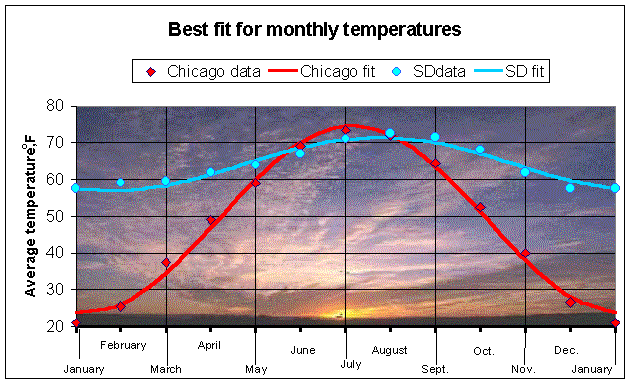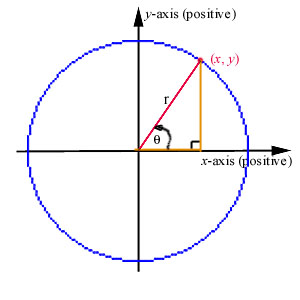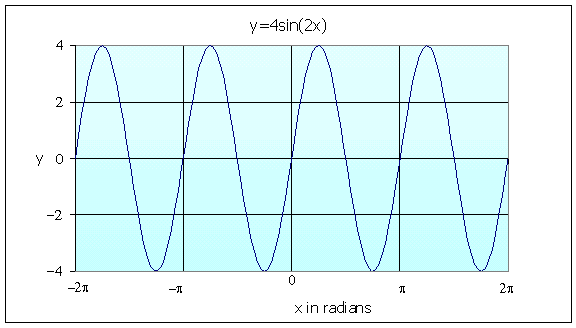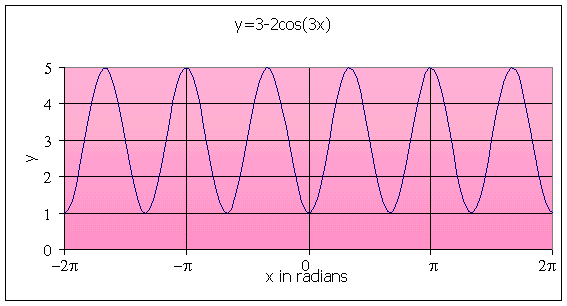|
|
Math 122 - Calculus for Biology II |
|
|---|---|---|
|
|
San Diego State University -- This page last updated 26-Aug-11 |
|
|
|
Math 122 - Calculus for Biology II |
|
|---|---|---|
|
|
San Diego State University -- This page last updated 26-Aug-11 |
|
Many phenomena in biology appear in cycles. Often these cycles are driven by the natural physical cycles that result from the daily cycle of light or the annual cycle of the seasons. Oscillations are most easily studied using trigonometric functions. This section begins with a discussion of annual temperature variations, then we review some trigonometric functions.Many phenomena in biology appear in cycles. Often these cycles are driven by the natural physical cycles that result from the daily cycle of light or the annual cycle of the seasons. Oscillations are most easily studied using trigonometric functions. This section begins with a discussion of annual temperature variations, then we review some trigonometric functions. The emphasis for this section is modeling oscillatory behavior with the sine and cosine functions.
Often the weather report states what the average expected temperature of a given day is. These averages are derived from long term collection of data on weather for a particular location. Clearly, there is a relatively wide variation from these averages, but they provide approximations to the expected weather for a particular time of year. The long term averages also provide a baseline to help researchers determine the predicts effects of global warming over the background noise of annual variation. Obviously, there are seasonal differences in the average daily temperature with higher averages in the summer and lower averages in the winter. Below we provide a table of showing the monthly average high and low temperatures for San Diego and Chicago.
|
|
|
|
|
|
|
|
|
|
|
|
|
|
|
|
|
|
|
|
|
|
|
|
|
|
|
|
|
|
|
|
|
|
|
|
|
|
|
|
|
|
|
|
|
|
|
|
|
|
|
|
What mathematical tools can help predict the annual temperature cycles? Polynomials and exponentials do not exhibit the periodic behavior that we see for these average monthly temperatures, so these functions are not appropriate for modeling this system. The most natural candidates for studying monthly temperatures are the trigonometric functions. Below are graphs of the average monthly temperatures for San Diego and Chicago, which are computed from the table by averaging the average high and low temperatures.

The two graphs above have some similarities and clear differences. They both show the same seasonal period as expected; however, the seasonal variation or amplitude of oscillation for Chicago is much greater than San Diego. Also, the overall average temperature for San Diego, being further south and near the ocean, is greater than the average for Chicago. The overlying models in the graph above use cosine functions. The fit using the cosine function provides a reasonable approximation though clearly there are errors due to other complicating factors in weather prediction. Before providing more details of the models for these temperature cycles, we review some basic facts about trigonometric functions.
The trigonometric functions are often called circular functions, which emphasizes their periodic nature and shows their connection to a circle. Let (x, y) be a point on a circle of radius r centered at the origin. Define the angle q between the ray connecting the point to the origin and the x-axis. (See the diagram below.)

The six basic trigonometric functions are defined in terms of x, y, and r (including the sign of x and y) shown in the diagram above by the following:

We will concentrate almost exclusively on the first two of these trigonometric functions, sine and cosine.
Before discussing the nature of the trigonometric functions in more detail, we need to discuss radian measure of the angle. If you have had trigonometry before, you probably used degrees to measure an angle. However, they are not the appropriate unit to use in Calculus. The easiest way to consider radian measure is to examine the unit circle (which is simply the circle in the diagram above with a radius of 1). From earlier courses, you may recall that the circumference of a circle is 2pr, so the distance around the perimeter of the unit circle is 2p. The radian measure of the angle q in the diagram above is simply the distance along the circumference of the unit circle. Thus, a 45o angle is 1/8 of the distance around the unit circle or p/4 radians. Similarly, 90o and 180o angles convert to p/2 and p radians, respectively. Below are formulae for converting from degrees to radians or radians to degrees:
A javascript is provided for easy conversions of degrees to radians or radians to degrees through a hyperlink.
From the formulae for sine (sin) and cosine (cos) above, we see that if you take a unit circle, then the cosine function gives the x value of the angle (measured in radians), while the sine function gives the y value of the angle. The tangent function (tan) gives the slope of the line (y/x). Below is a graph of the sine and cosine functions for the angles from -2p to 2p, i.e., the graph shows sin(x) and cos(x) for -2p < x < 2p. (Note that the x here is the angular measurement, which is the q argument above and not the x, which measures the adjacent side of the triangle.)

There are several things to notice about these graphs. First, you notice the 2p periodicity. In other words, the functions repeat the same pattern every 2p radians. This is clear from the circle above because every time you go 2p radians around the circle, you return to the same point. The second point is that both the sine and cosine functions are bounded between -1 and 1. The sine function has its maximum value at p/2 with sin(p/2) = 1 and its minimum value at 3p/2 with sin(3p/2) = -1. Because of the periodicity, these extrema reoccur every integer multiple of 2p.
Below is an applet to help you link the picture of the circle above and the trigonometric functions, sine and cosine, graphed above, using the dynamics of an applet. Click on the applet to place the point. The table below the applet gives the angle in degrees and radians and values of the sine and cosine functions at the angle chosen.
Below is a table of some important values of the trig functions to remember.
|
|
|
|
|
|
|
|
|
|
|
|
|
|
|
|
|
|
|
|
|
|
|
|
|
|
|
|
|
|
|
|
|
|
|
|
Properties and Identities for Sine and Cosine
There are a number of properties that are significant for sine and cosine.
Properties of Cosine
Properties of Sine
When studying trigonometry, there are many special trigonometric identities that are frequently learned. We are going to highlight a very few that are particularly useful.
Some Identities for Sine and Cosine
The first of these identities is readily verified using Pythagorean's Theorem
and the definitions of sine and cosine. The second two identities are not as
easily shown, and we will omit their proofs here {Proofs use basic
definitions of the sine and cosine functions - last visited 8/11}. The second two identities are
useful in showing that from a modeling perspective, the sine and cosine functions
are often interchangeable.
Example: Use the trigonometric properties and identities to show that
cos(x) = sin(x + p/2)
and
sin(x) = cos(x - p/2)
Solution: From the additive formula for sine functions
sin(x + p/2) = sin(x)cos(p/2) + cos(x)sin(p/2)
By our properties above, we know cos(p/2) = 0 and sin(p/2) = 1, so
sin(x + p/2) = cos(x)
This relationship says that the cosine function is exactly the same as the sine
function, but shifted out of phase by -p/2 (or the sine curve shifted
to the left by p/2).
Using the subtractive identity formula for cosine functions
cos(x - p/2) = cos(x)cos(p/2) + sin(x)sin(p/2)
Again cos(p/2) = 0 and sin(p/2) = 1, so
cos(x - p/2) = sin(x)
This relationship says that the sine function is exactly the same as the cosine function, but shifted out of phase by p/2 (or the sine curve shifted
to the right by p/2).
Period, Amplitude, Phase and Vertical Shift
The sine and cosine functions above have a period of 2p and an amplitude of one, so how can we adjust these functions to fit other periodic data, such as the temperature data for Chicago and San Diego given in the introduction to this section? hen data follows a simple oscillatory behavior, then a general modeling form using the cosine function is
y(x) = A + B cos(w(x - f)),
while a closely related model using the sine function is
y(x) = A + B sin(w(x - f)).
There are four parameters in these models. The first parameter is A, which gives the vertical shift of the models. The parameter B gives the amplitude of the oscillations in the models.
Vertical Shift and Amplitude
The parameter w is the frequency of the models.
Frequency and Period
T = 2p/w
It is the periodic nature of the models for which these functions have been chosen.
The last parameter, f, is the phase shift.
Phase Shift
When fitting the cosine and sine models, there
are choices that can be made with the parameters. The parameter, A, is unique.
The parameters for amplitude and frequency, B and w, are unique in
magnitude, but the sign of the parameter can be chosen by the modeler. Usually,
we prefer to take the parameters B and w to be positive. Because of the
periodicity of these trigonometric functions, there are infinitely many possible
choices for the phase shift, f. However, it is customary to select the phase
shift satisfying 0 < f < T, the
principle phase shift. By taking the principle phase shift and positive values for the amplitude and frequency, then the four
parameters in the cosine and sine models, A, B, w, and f, are
unique.
Example: Find the period and amplitude of
Determine all maxima and minima for -2p < x < 2pand sketch the graph.
Solution: From the information above, we see that the amplitude of this function is B = 4, which says that it oscillates between -4 and 4, and the period is p. The easiest way to find the period T is to let x = T in the function, then set the argument of the trig function to 2p, and finally solve this for T.
From our table above, this function begins at 0 when x = 0. It achieves a maximum of 4 at x = p/4, where the argument is p/2. The function decreases to a minimum of -4 at x = 3p/4, where the argument is 3p/2, then increases to where it completes its cycle at x = p. By periodicity, there are other maxima at x = p + p/4 = 5p/4, x = -p + p/4 = -3p/4, and x = -9p/4. Similarly, there are other minima at x = -5p/4, -p/4, and 7p/4.
The sine function is an odd function, so the graph is symmetric about the origin. The graph is shown below for -2p < x < 2p.

Example: Consider a model given by
for 0 < x < 2p. Find the vertical shift, period, and amplitude of this model. Determine all minima and maxima in the domain and sketch the graph.
Solution: This function is shifted vertically by the constant A = 3. The amplitude is the B = 2 multiplying the cosine function, but now the graph will oscillate between 1 < y < 5. The easiest way to determine the high and low points of the graph is to realize that the largest and smallest values of the cosine function are 1 and -1.
To find the period, T, we solve
The easiest way to find a minimum or maximum is to use the largest and smallest values of the cosine function, 1 and -1, which occur when the argument is 0 and p. Hence, when x = 0, cos(3x) = 1 and
y(0) = 3 - 2 cos(0) = 1,
which is a minimum. Wwhen x = p/3, cos(3x) = cos(p) = -1 and
y(p/3) = 3 - 2 cos(p/3) = 5,
which is a maximum. By periodicity, the other minima occur at integer multiples of 2p/3, which gives the minima in the domain at x = 0, 2p/3, 4p/3, and 2p. Similarly, the maxima in the domain occur at x = p/3, p, and 5p/3.
Below is a graph of this function.

We can insert a phase shift of half a period to make the constant for the amplitude be positive and produce the same model. Consider the model with a half period phase shift given by
y(x) = 3 + 2 cos(3(x - p/3))
To show this is the same model we employ the angle subtraction identity for the cosine function.
y(x) = 3 + 2 cos(3(x - p/3))
= 3 + 2 cos(3x - p)
= 3 + 2(cos(3x)cos(p) + sin(3x)sin(p))
= 3 - 2cos(3x)
since cos(p) = -1 and sin(p) = 0.
Phase Shift of Half a Period
A phase shift of half a period creates an equivalent sine or cosine model with the sign of the amplitude reversed.
The example above shows this property.
As usual, there are more examples worked the Examples Section found through the hyperlink.
The sine and cosine models are equivalent when the vertical shift, period, and amplitude are the same. Only the phase shift differs, and our trigonometric identities readily find this difference in the phase shift.
Phase Shift for Equivalent Sine and Cosine Models
Suppose that the sine and cosine models are equivalent, so
sin(w(x - f1)) = cos(w(x - f2)).
The relationship between the phase shifts, f1 and f2 satisfies:
f1 = f2 - p/2w
The identity above is easily shown using the result from the example above for the additive identities:
sin(w(x - f1)) = cos(w(x - f1) - p/2) = cos(w(x - f2)).
Equating arguments of the cosine function gives
w(x - f1) - p/2 = w(x - f2)
-wf1 - p/2 = -wf2
f1 = f2 - p/(2w)
Note: It is important to remember that the phase shift is not unique and can vary by integer multiples of the period, T = 2p/w.
Return to the Annual Temperature Variation
At the beginning of this section, there is an example showing the temperature variation between the seasons for Chicago and San Diego. We want to show what the mathematical models are for the curves in the graphs and explain them in terms of the definitions listed above to give you a better intuitive feel for the period, amplitude, phase shift, and vertical shift. The cosine model has the form
T(m) = A + B cos(w(m - f)),
where T is the average monthly temperature and m is the month with January = 0. We need to find the appropriate values for the parameters A, B, w, and f, and we
want to select B > 0, w > 0, and 0 < f < P, where
P is the period of the model. The method for fitting the actual data to
the model employs a couple of techniques. First, we know that the period of
this function must be 12 months. This constrains our parameter w
to satisfy
12w = 2p or w = p/6 = 0.5236.
We know that the cosine function oscillates around its average, so the value of A, which gives the vertical shift, is the average of the monthly temperatures. From the Table above, we can find the average temperature of San Diego for each month by averaging the minimum and maximum temperatures recorded each month. The average temperature for the year satisfies:
A = (57.5+59+59.5+62+64+67+71+72.5+71.5+68+62+57.5)/12 = 64.29,
while for Chicago, we find
A = 49.17.
There are a several ways to obtain fits for the parameters B and f. We chose to find a nonlinear least squares fit to these parameters with Excel's Solver, which is covered in the Computer Lab. The model for the average monthly temperature in San Diego is given by
T(m) = 64.29 + 7.29 cos(0.5236(m - 6.74)),
while the average monthly temperature in Chicago follows the formula
T(m) = 49.17 + 25.51 cos(0.5236(m - 6.15)),
again T is the average monthly temperature and m is the month with January = 0.We have discussed the vertical shift (average temperature given by A) and the period (12 months giving a frequency of w = p/6 = 0.5236). The amplitude is given by the parameter B, which represents the maximum amount the temperature varies from the annual average. With its "Mediterranean" climate, San Diego has the significantly lower amplitude with only a 7.29 oF variation higher and lower than its average annual temperature, while Chicago has a temperature variation of 25.51 oF above and below its lower average of 49.17 oF. Thus, our model predicts that the temperature of San Diego will vary from 57.0 oF to 71.58 oF (average daily temperature), while Chicago will vary from 23.66 oF to 74.68 oF (average daily temperature). These should be apparent from the graph above.
Finally, we need to interpret the phase shift, f. For San Diego, we see a phase shift of f = 6.74 months. This means that the maximum temperature occurs at 6.74 months (late July), instead of January, as we would expect. For Chicago, the phase shift is f = 6.15 months, which gives the high occurring a little earlier (early July) in Chicago. Be sure to view the original graph and match how the parameters are reflected in this graph as it is important for understanding the use of trigonometric functions.
The cosine models given above for the average temperature of San Diego and Chicago can be rewritten with the sine function,
T(m) = A + B sin(w(m - f2)).
The values for A, B, and w are the same for both the sine and cosine models. However, the phase shift for the sine model differs from the cosine model. The formula above shows that the sine phase shift, f2, satisfies
f2 = f - p/(2w),
where f is the phase shift from the cosine model. This formula gives f2 = 3.74 for San Diego and f2 = 3.15 for Chicago. This phase shift for the sine model is a quarter of the period less than the phase shift for the cosine model. Thus, we write the sine models for the average monthly temperature in San Diego,
T(m) = 64.29 + 7.29 sin(0.5236(m - 3.74)),
and the average monthly temperature in Chicago,
T(m) = 49.17 + 25.51 sin(0.5236(m - 3.15)).
These models produce exactly the same graphs as seen in the original graph.
[1] Rand McNally Map and Travel Information, 2000.